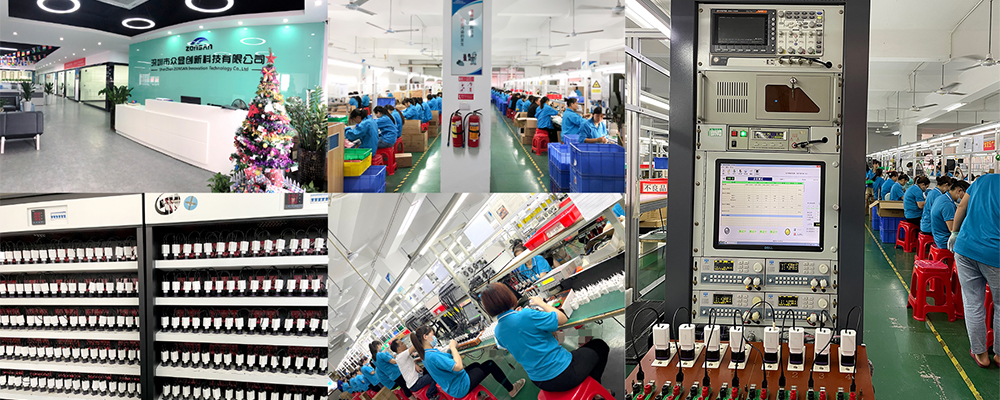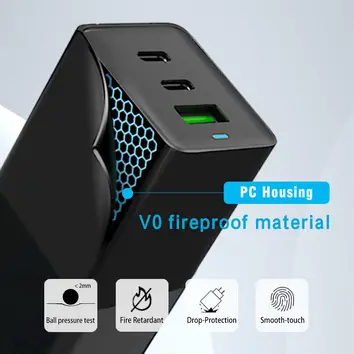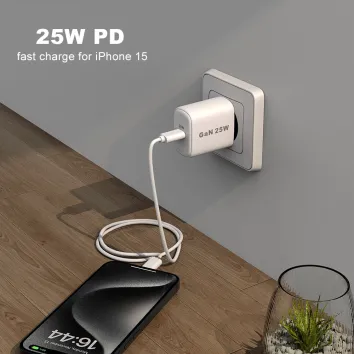Zonsan recommends: Choose the best GaN charger for you!
This charger is for you... If you want...
ZX-1U69T 25W —— This is a charger that can be used for all devices and is also the best-selling product.
Small and portable,cheap,and equipped with Type C fast charging port.
ZX-2U69T 45W —— Equipped with USB-A & USB-C ports,it is suitable for charging all mobile phones and electronic devices.
ZX-2U73T 65W —— Convenient charger, suitable for use in any scenario. This is our best-selling product.
ZX-3U30T 100W —— Convenient charger, suitable for use in any scenario.
ZX-5U09T 240W —— A large number of USB-C and USB-A ports, and a compact charger.
ZX-4U21T 140W —— A high-powered, compact desktop charger with 4 ports is the most desired in your office area.

ZX-2U73T 65W —— Convenient charger, suitable for use in any scenario. This is our best-selling product.
ZX-3U30T 100W —— Convenient charger, suitable for use in any scenario.
ZX-5U09T 240W —— A large number of USB-C and USB-A ports, and a compact charger.
ZX-4U21T 140W —— A high-powered, compact desktop charger with 4 ports is the most desired in your office area.

When choosing a GaN charger, there are several key factors to consider, which directly affect its quality and practicality.
Consumers generally consider the following points:
- Interface type: Consider the device requirements. Do you only need a USB-C interface, or do you still need a USB-A interface that is compatible with traditional devices?
Consumers generally consider the following points:
- Interface type: Consider the device requirements. Do you only need a USB-C interface, or do you still need a USB-A interface that is compatible with traditional devices?
- Power output: If you mainly use mobile phones and tablet devices, a charger with a 25W to 65W output is usually sufficient. To charge high-power devices such as laptops, you need a charger with at least 100W or even 140W output.
- Number of ports: Multi-port chargers are more practical, but they are usually larger and heavier (fortunately GaN technology can make high-power chargers more compact and lightweight)
- Interchangeable plugs: If you travel frequently (going abroad), it is most convenient to choose a charger with a plug that can be converted.
- Actual needs and thinking needs: For example, some people think "the bigger the better" and "may be useful", but if you need to carry it with you, especially when traveling, portability and lightness may be more important. Choosing the right charger according to the specific usage scenario can better meet the needs.
How we develop and test GaN chargers
Zonsan tests dozens of GaN chargers every year in test laboratories and real-world conditions, and develops chargers that are more advantageous and meet user needs based on the characteristics of the chargers and user needs.
· Can it meet user needs? It is not as simple as designing, producing, and testing to know whether it will eventually meet the requirements. We test the chargers under heavy load and continuous load, and take the chargers to professional laboratories for multiple tests (temperature/fire protection/electricity protection/fall protection/material testing, etc.). Single-port load and multi-port load conditions also need to be tested to ensure that they meet the specifications. To get a passing score or above, the charger needs to be debugged several times.
· The safety of the charger! Multiple electrical safety tests, thermal measurements, and compliance certificates issued by professional organizations are required! —— Because no one wants the charger at home to overheat and cause safety hazards.
· Is it durable. Can it withstand repeated plugging and unplugging? Is the port quality good? Can the charger withstand being dropped and kicked? Because it will encounter wear and tear in daily use, especially travel chargers.

Analysis of GaN chargers: What is gallium nitride?
Gallium nitride (GaN) is a semiconductor material with unique properties, and its chemical formula is GaN. Since the 1990s, GaN materials have been used in the electronic field, first used in LED technology for backlighting of TVs and monitors. Subsequently, this material entered the field of transistors and has gradually replaced the industry's previous favorite semiconductor material: silicon, becoming the first choice for efficient electronic devices.
GaN transistors (also known as GaN FETs) are smaller than traditional silicon transistors, can carry more power, and have higher switching speeds and energy efficiency. These advantages make it an ideal choice for modern USB-C adapters and fast chargers. In comparison, silicon transistors are about 87% efficient, while GaN transistors can increase efficiency to more than 95%, which means they can reduce energy loss and waste heat generation.
Higher energy efficiency also means that GaN chargers can provide the same or even higher power output in a more compact size. So not only does this make today's chargers smaller and more portable, but it also makes high-power chargers safer to use because it reduces heat generation.

Why are GaN chargers more efficient?
Because the more efficient the electronic components, the less waste heat they generate. As mentioned above, GaN transistors are smaller than silicon transistors, and transistors act like tiny electronic switches. GaN transistors can switch about four times faster than silicon transistors, up to 40 million times per second. This allows the charger to control the current output more quickly and accurately, thereby increasing charging speed and reducing energy consumption.
- Number of ports: Multi-port chargers are more practical, but they are usually larger and heavier (fortunately GaN technology can make high-power chargers more compact and lightweight)
- Interchangeable plugs: If you travel frequently (going abroad), it is most convenient to choose a charger with a plug that can be converted.
- Actual needs and thinking needs: For example, some people think "the bigger the better" and "may be useful", but if you need to carry it with you, especially when traveling, portability and lightness may be more important. Choosing the right charger according to the specific usage scenario can better meet the needs.
How we develop and test GaN chargers
Zonsan tests dozens of GaN chargers every year in test laboratories and real-world conditions, and develops chargers that are more advantageous and meet user needs based on the characteristics of the chargers and user needs.
· Can it meet user needs? It is not as simple as designing, producing, and testing to know whether it will eventually meet the requirements. We test the chargers under heavy load and continuous load, and take the chargers to professional laboratories for multiple tests (temperature/fire protection/electricity protection/fall protection/material testing, etc.). Single-port load and multi-port load conditions also need to be tested to ensure that they meet the specifications. To get a passing score or above, the charger needs to be debugged several times.
· The safety of the charger! Multiple electrical safety tests, thermal measurements, and compliance certificates issued by professional organizations are required! —— Because no one wants the charger at home to overheat and cause safety hazards.
· Is it durable. Can it withstand repeated plugging and unplugging? Is the port quality good? Can the charger withstand being dropped and kicked? Because it will encounter wear and tear in daily use, especially travel chargers.

Analysis of GaN chargers: What is gallium nitride?
Gallium nitride (GaN) is a semiconductor material with unique properties, and its chemical formula is GaN. Since the 1990s, GaN materials have been used in the electronic field, first used in LED technology for backlighting of TVs and monitors. Subsequently, this material entered the field of transistors and has gradually replaced the industry's previous favorite semiconductor material: silicon, becoming the first choice for efficient electronic devices.
GaN transistors (also known as GaN FETs) are smaller than traditional silicon transistors, can carry more power, and have higher switching speeds and energy efficiency. These advantages make it an ideal choice for modern USB-C adapters and fast chargers. In comparison, silicon transistors are about 87% efficient, while GaN transistors can increase efficiency to more than 95%, which means they can reduce energy loss and waste heat generation.
Higher energy efficiency also means that GaN chargers can provide the same or even higher power output in a more compact size. So not only does this make today's chargers smaller and more portable, but it also makes high-power chargers safer to use because it reduces heat generation.

Why are GaN chargers more efficient?
Because the more efficient the electronic components, the less waste heat they generate. As mentioned above, GaN transistors are smaller than silicon transistors, and transistors act like tiny electronic switches. GaN transistors can switch about four times faster than silicon transistors, up to 40 million times per second. This allows the charger to control the current output more quickly and accurately, thereby increasing charging speed and reducing energy consumption.
Consumer concerns: Charger heating problems
Many consumers are worried that the charger will become too hot to touch during use. But chargers using GaN technology rarely feel a bit hot. Even at high power output, the surface temperature is only slightly warm, not too hot.
After understanding GaN, I believe you can understand why more and more consumers and manufacturers are turning to GaN technology.
How high is too hot for a charger?
When factories test equipment, they usually follow the temperature standards (national/international standards) for chargers of different power levels, and unqualified products will not be produced. So there is no need to worry about whether the charger temperature is too high. According to the safe "no harm" temperature range chart, above a certain temperature, people will no longer feel hot, but start to feel pain.
The ASTM C1055 (the Standard Guide for Heated System Surface Conditions that Produce Contact Burn Injuries) states that the average person can touch objects up to 60°C/140°F for up to five seconds without sustaining irreversible burn injuries.
Are there alternative best GaN accessories worth considering?
If you are looking for a more specific charger, consider these top picks for the best GaN accessories.Or please click here to contact us for consultation.

Read More

Read More

Read More

Read More